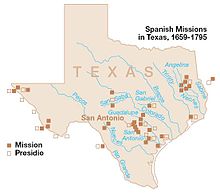If we trace the true origins of Tex-Mex all the way back, we arrive at a time hundreds of years ago when Spanish and Mexican foods were combined with Anglo-American food. During the early years of America, settlers and explorers were introduced to unfamiliar Mexican dishes and cultures from the area that would become modern day Texas.* Many of them integrated the new food onto their tables, starting the trend of Tex-Mex.
However, this is not the wide-spread Tex-Mex that exists today. The modern Tex-Mex is quite different, and a very recent phenomenon, with its beginnings rooted only in the twentieth century. The history of the word itself is actually quite notable. A few decades before the term was attached to food, "Tex-Mex" originated in order to describe something else that was Mexican American: transportation.
The word "Tex-Mex" actually first appeared in the English language as a nickname for the Texas Mexican Railway, which was chartered in 1875. As many railroads were given abbreviations in the media, the Texas Mexican railway was abbreviated Tex. Mex. Then in the 1920s, the hyphenated form of the word began entering American newspapers in reference to not only the railroad but also to describe people of Mexican ancestry born in Texas.
Okay...so what does all of that have to do with the food? Well, because of this previous usage of the word "Tex-Mex", the term had become an icon for not just simply a relation but a fusion of Mexican and American culture. When the name was finally applied to food, it was used to finally indicate the hybrid nature of the modern cuisine and differentiate it from traditional Mexican food. A bit ironically, Tex-Mex food is inherently a fusion of multiple tastes and distinct culinary cultures, not only American and Mexican. The fare includes influences from Mexico, Spain, America, and traces of India. At the same time, Tex-Mex is considered to be native to (originated from) the United States. It is indeed a very mixed cuisine.
 |
| Tex-Mex seller, 1939 |
The beginning of the actual cuisine is credited to Tejano cooks who started adapting Mexican dishes to American tastes in the 1900's. However, Tex-Mex only started gaining momentum as an official food culture around the mid-twentieth century. The word "Tex-Mex" itself was not used to describe food until around the 1940's, with the first printed evidence of the word in direct reference to the cuisine occurring in 1945. Many "Mexican" restaurants began cropping up in the 1950's, which coincided with a movement of Mexican immigrants to the U.S. Many of these newcomers were poor and, due to the cheaper prices of American ingredients, boosted the integration of Mexican and American fare.
The real boom for the spread of Tex-Mex came in the 1970's with the publishing of an influential cookbook by Diana Kennedy, The Essential Cuisines of Mexico, which drew the line between authentic Mexican food and Tex-Mex eaten in U.S. restaurants. Even though many contemporary restaurant owners took this as an insult, it launched Tex-Mex into the eye of the culinary world and its popularity grew tremendously. More restaurants began cropping up all over America, and some even began spreading to other countries.
However, an important point to note is that these new restaurants emulated the previously established "Mexican" restaurants; they presented themselves under the name of Mexican food and not Tex-Mex or Mexican-American cuisine. As a result, to this day most casual eaters at "Mexican" restaurants in America are unaware of the erroneous image thrown over their food. It may be broadcast as Mexican, but it is not Mexican. Rather, it is a separate cuisine.___________________________________________________________
*Evidence can be traced back to the late seventeenth century when Spanish authorities sent missionaries into the area of East Texas. Spanish, Mexican (what was then part of New Spain), and native dishes were combined to form a sort of hybrid fare.




No comments:
Post a Comment